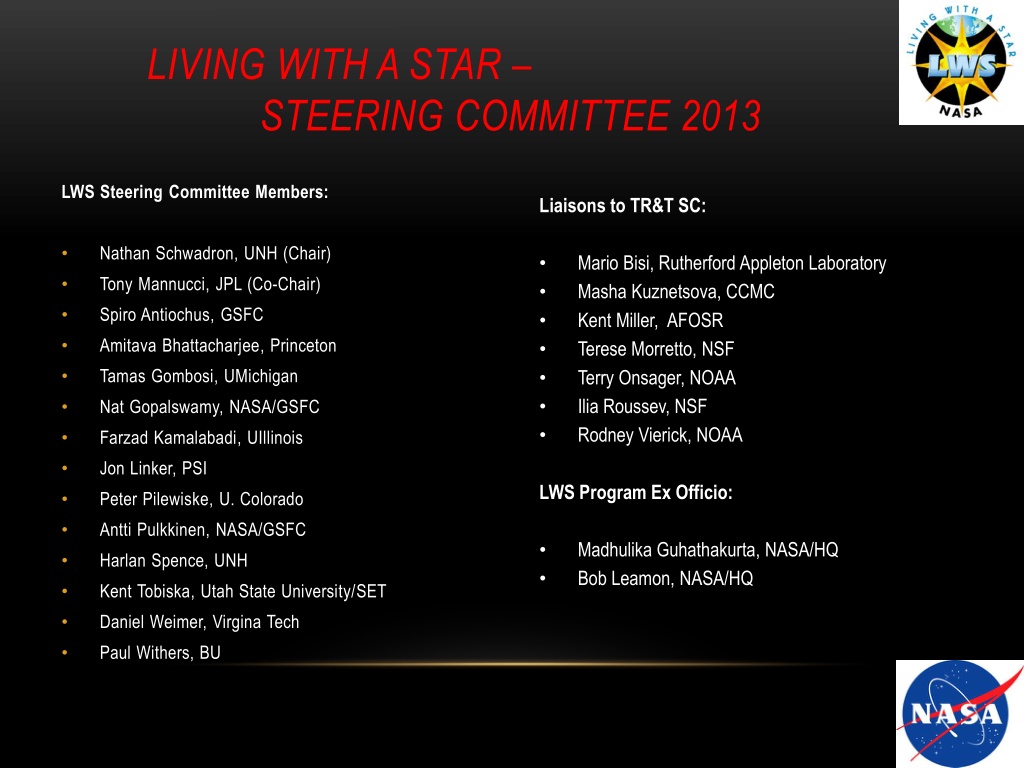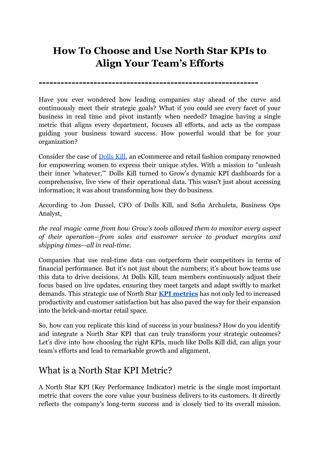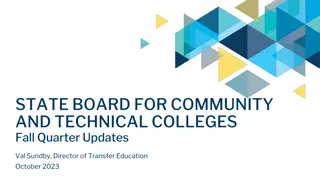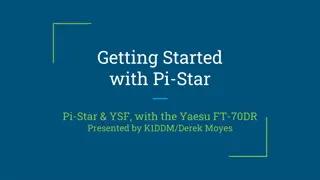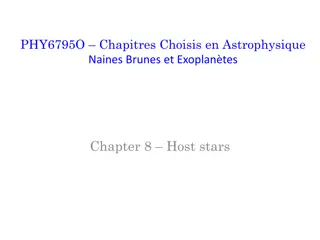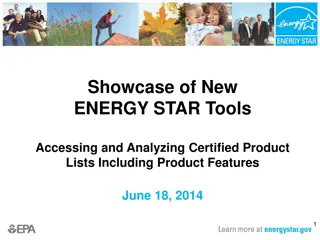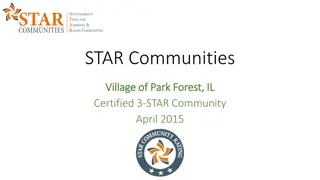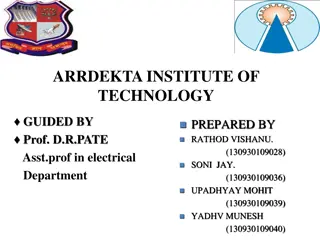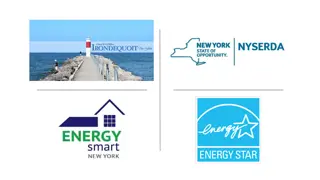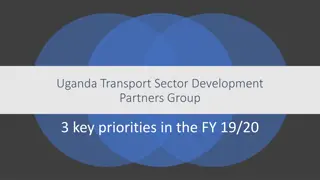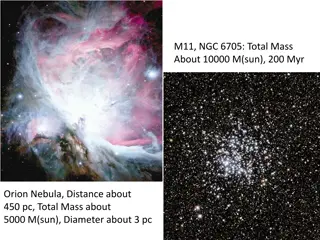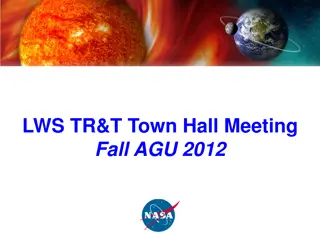Advancing the Living with a Star Program: Science Goals and Community Priorities
The Living with a Star (LWS) program, led by a dedicated steering committee, aims to provide yearly reports, set long-term visions, and address key science topics in solar and space physics. The community priorities include enabling discovery and addressing societal needs, emphasizing the importance of scientific advancements for societal benefit. The program focuses on strategic science topics such as geomagnetic forecasting, satellite drag forecasting, solar energetic particle forecasting, ionosphere and plasmasphere density forecasting, scintillation forecasting, and radiation environment forecasting to advance our understanding of space weather phenomena and protect society.
Download Presentation

Please find below an Image/Link to download the presentation.
The content on the website is provided AS IS for your information and personal use only. It may not be sold, licensed, or shared on other websites without obtaining consent from the author. Download presentation by click this link. If you encounter any issues during the download, it is possible that the publisher has removed the file from their server.
E N D
Presentation Transcript
LIVING WITH A STAR STEERING COMMITTEE 2013 LWS Steering Committee Members: Liaisons to TR&T SC: Nathan Schwadron, UNH (Chair) Mario Bisi, Rutherford Appleton Laboratory Masha Kuznetsova, CCMC Kent Miller, AFOSR Terese Morretto, NSF Terry Onsager, NOAA Ilia Roussev, NSF Rodney Vierick, NOAA Tony Mannucci, JPL (Co-Chair) Spiro Antiochus, GSFC Amitava Bhattacharjee, Princeton Tamas Gombosi, UMichigan Nat Gopalswamy, NASA/GSFC Farzad Kamalabadi, UIllinois Jon Linker, PSI LWS Program Ex Officio: Peter Pilewiske, U. Colorado Antti Pulkkinen, NASA/GSFC Madhulika Guhathakurta, NASA/HQ Bob Leamon, NASA/HQ Harlan Spence, UNH Kent Tobiska, Utah State University/SET Daniel Weimer, Virgina Tech Paul Withers, BU
TASKS OF THE STEERING GROUP Provide a yearly report with new Focus Topics Provide a top-level 10 year vision for the LWS program
LWS COMMUNITY PRIORITIES Enabling discovery (Chapter 1) & Addressing Societal Needs (Chapter 3) LWS central to the decadal survey s strategy is the intent to achieve scientific results that will be useful to society Given adequate resources, the research community should be able to leverage advances in computing capability to develop the predictive models required to specify the extended space environment in order to protect society and advance growing aspirations for the use of space. Solar and Space Physics: A Science for a Technological Society 3
WHAT ARE WE TRYING TO ACHIEVE? Examples of Long-term Strategic Science Topics Physics-based Geomagnetic Forecasting Capability Enable1-3 day (long lead-time) and 15-30 min (short lead-time) predictions of pending extreme fluctuations in geomagnetic field Physics-based Satellite Drag Forecasting Capability Enable specification of the global neutral density in the thermosphere and its variations over time Physics-based Solar Energetic Particle Forecasting Capability Probabilistic prediction of the intensity of SEP events, and increased time periods for all-clear forecasting capability with higher confidence level Physics-based TEC Forecasting Capability Enable specification of the global ion density in the topside ionosphere and plasmasphere and its variations over time under varying geomagnetic conditions Physics-based Scintillation Forecasting Capability Enable prediction of scintillation occurrence utilizing limited sources of available data and ascertain how radio signals are degraded by ionospheric irregularities Physics-based Radiation Environment Forecasting Capability Enable predictive capability for the radiation environment and its effective dose as well as dose rates based on GCR, SEP, cutoff rigidity, atmosphere density, and gamma-ray/X-ray inputs
WHERE IS THE MISSING PHYSICS (1/2) Interdisciplinary areas with varying levels of model & physics development Example: Solar Energetic Particles Incorporation of Plasma Environment Realistic Corona CMEs Solar Wind Seed populations Ambient Waves and Self-Generated Waves Realization of global models through inner heliosphere with predictive capability
WHERE IS THE MISSING PHYSICS (2/2) Thermosphere & Ionosphere X-scale coupling Coupling across scales Magnetosphere Lower atmosphere (small scale gravity waves * planetary waves) Ion-neutral Coupling between ionosphere and thermosphere Magnetosphere-Ionosphere coupling Ability to predict disturbances in solar wind Realization of global models with physical couplings and predictive capability
HOW DO WE FILL IN THE PHYSICS TO DEVELOP PREDICTABILITY Chicken and egg problem Need to develop initial models and validation to know what you don t know Need to incorporate the physics in models Validation is absolutely essential In all areas, we need to go deeper into the physics to achieve predictability The physics crosses all boundaries we define Requires an interdisciplinary approach! Remain focused on the LWS goals Architecture of LWS critical Structure of LWS has served us well over the last decade build on the foundation of LWS
HOW DO WE DEVELOP THE LWS ARCHITECTURE LWS MOWG has been essential over the last decade Foundation of the LWS Program LWS Architecture Report led by Mason Initial LWS Science TR&T Definition led by Gosling LWS Project Office Next step in LWS Architecture under formulation by Steering Committee Focus on Strategic Science Topics with Goal of Enabling Predictability
INTERACTION WITH USER COMMUNITIES FST, SC and TST teams partner with members of key space weather centers (e.g., CCMC, NASA/SRAG, and NOAA/SWPC) facilitate better interaction with user communities deliverables that best serve user needs. Upon team selection, NASA/HQ will contact relevant modeling centers to identify liaisons to appropriate user communities.
EXAMPLES OF FST TOPICS IN 2013 REPORT Physics-based Predictive Capability Development for Geomagnetically Induced Current (GIC) Events Physics-based predictive capability development for changes in the composition of the thermosphere during extreme events Physics-based Predictive Capabilities for Solar Eruptions Physics-based methods to predict connectivity of SEP sources to points in the inner heliosphere, tested by location, timing, and longitudinal separation of SEPs Ion-Neutral Interactions in the Topside Ionosphere Radio Scintillation Prediction in Mid-latitude Ionosphere Physics-based predictive capability development for the radiation environment from the lower atmosphere to beyond the upper atmosphere during quiet and storm conditions
TAKE AWAYS LWS Fundamentally Rooted in the Science and Goals Laid out by the SSP Decadal Survey LWS Architecture critical to achieving strategic goals Complement HPS Roadmap and SSP Decadal Survey Builds on LWS foundation created over last decade Strategic Science Topics Long-term goals for predictive capability development
